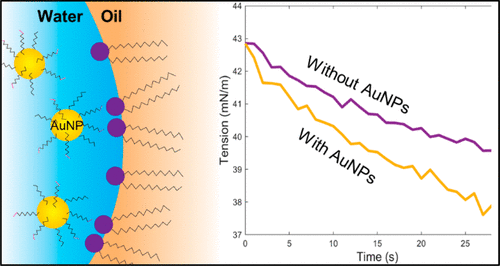Our official English website, www.x-mol.net, welcomes your
feedback! (Note: you will need to create a separate account there.)
Nanoparticle-Induced Disorder at Complex Liquid–Liquid Interfaces: Effects of Curvature and Compositional Synergy on Functional Surfaces
ACS Nano ( IF 15.8 ) Pub Date : 2021-09-13 , DOI: 10.1021/acsnano.1c02663 Colin M Basham 1 , Uvinduni I Premadasa 2 , Ying-Zhong Ma 2 , Francesco Stellacci 3 , Benjamin Doughty 2 , Stephen A Sarles 1
ACS Nano ( IF 15.8 ) Pub Date : 2021-09-13 , DOI: 10.1021/acsnano.1c02663 Colin M Basham 1 , Uvinduni I Premadasa 2 , Ying-Zhong Ma 2 , Francesco Stellacci 3 , Benjamin Doughty 2 , Stephen A Sarles 1
Affiliation

|
The self-assembly of surfactant monolayers at interfaces plays a sweeping role in tasks ranging from household cleaning to the regulation of the respiratory system. The synergy between different nanoscale species at an interface can yield assemblies with exceptional properties, which enhance or modulate their function. However, understanding the mechanisms underlying coassembly, as well as the effects of intermolecular interactions at an interface, remains an emerging and challenging field of study. Herein, we study the interactions of gold nanoparticles striped with hydrophobic and hydrophilic ligands with phospholipids at a liquid–liquid interface and the resulting surface-bound complexes. We show that these nanoparticles, which are themselves minimally surface active, have a direct concentration-dependent effect on the rapid reduction of tension for assembling phospholipids at the interface, implying molecular coassembly. Through the use of sum frequency generation vibrational spectroscopy, we reveal that nanoparticles impart structural disorder to the lipid molecular layers, which is related to the increased volumes that amphiphiles can sample at the curved surface of a particle. The results strongly suggest that hydrophobic and electrostatic attractions imparted by nanoparticle functionalization drive lipid–nanoparticle complex assembly at the interface, which synergistically aids lipid adsorption even when lipids and nanoparticles approach the interface from opposite phases. The use of tensiometric and spectroscopic analyses reveals a physical picture of the system at the nanoscale, allowing for a quantitative analysis of the intermolecular behavior that can be extended to other systems.
中文翻译:

复杂液-液界面的纳米颗粒诱导的紊乱:曲率和成分协同作用对功能表面的影响
界面处表面活性剂单层的自组装在从家庭清洁到呼吸系统调节的任务中发挥着广泛的作用。界面上不同纳米级物质之间的协同作用可以产生具有特殊特性的组件,从而增强或调节它们的功能。然而,了解共组装的潜在机制以及界面上分子间相互作用的影响仍然是一个新兴且具有挑战性的研究领域。在此,我们研究了带有疏水性和亲水性配体的金纳米粒子与液-液界面处的磷脂以及由此产生的表面结合复合物的相互作用。我们表明,这些纳米颗粒本身的表面活性极低,对在界面处组装磷脂的张力的快速降低具有直接的浓度依赖性影响,这意味着分子共组装。通过使用和频生成振动光谱,我们发现纳米颗粒赋予脂质分子层结构无序,这与两亲分子可以在颗粒曲面上采样的体积增加有关。结果强烈表明,纳米颗粒功能化赋予的疏水性和静电吸引力驱动了界面处的脂质 - 纳米颗粒复合物组装,即使当脂质和纳米颗粒从相反的相接近界面时,这也会协同促进脂质吸附。张力测量和光谱分析的使用揭示了系统在纳米尺度上的物理图像,
更新日期:2021-09-28
中文翻译:

复杂液-液界面的纳米颗粒诱导的紊乱:曲率和成分协同作用对功能表面的影响
界面处表面活性剂单层的自组装在从家庭清洁到呼吸系统调节的任务中发挥着广泛的作用。界面上不同纳米级物质之间的协同作用可以产生具有特殊特性的组件,从而增强或调节它们的功能。然而,了解共组装的潜在机制以及界面上分子间相互作用的影响仍然是一个新兴且具有挑战性的研究领域。在此,我们研究了带有疏水性和亲水性配体的金纳米粒子与液-液界面处的磷脂以及由此产生的表面结合复合物的相互作用。我们表明,这些纳米颗粒本身的表面活性极低,对在界面处组装磷脂的张力的快速降低具有直接的浓度依赖性影响,这意味着分子共组装。通过使用和频生成振动光谱,我们发现纳米颗粒赋予脂质分子层结构无序,这与两亲分子可以在颗粒曲面上采样的体积增加有关。结果强烈表明,纳米颗粒功能化赋予的疏水性和静电吸引力驱动了界面处的脂质 - 纳米颗粒复合物组装,即使当脂质和纳米颗粒从相反的相接近界面时,这也会协同促进脂质吸附。张力测量和光谱分析的使用揭示了系统在纳米尺度上的物理图像,











































 京公网安备 11010802027423号
京公网安备 11010802027423号